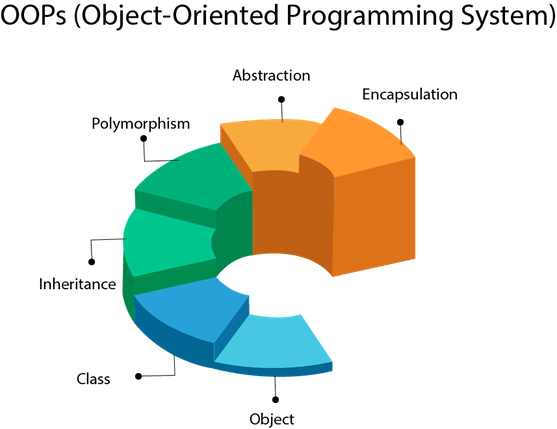Object-Oriented Programming (OOP)
Object-Oriented Programming (OOP) is a fundamental paradigm in software development that emphasizes the concept of objects, encapsulation, inheritance, and polymorphism. oop in Java, being a popular and versatile programming language, fully supports OOP principles and provides a robust framework for building scalable and maintainable applications. In this comprehensive guide, we will explore the key concepts of OOP in Java, including classes, objects, inheritance, polymorphism, encapsulation, abstraction, and more. We will delve into the syntax and features of Java that enable OOP, and we will discuss best practices for designing and implementing object-oriented programs. By the end of this article, readers will have a solid understanding of OOP in Java and be equipped with the knowledge to write efficient, reusable, and modular code.
OOP in java:
Object-Oriented Programming (OOP) is a powerful paradigm widely used in software development. It provides a structured approach to designing and implementing complex systems by organizing code into reusable objects. Java, one of the most popular programming languages, fully supports OOP principles and offers a rich set of features for building robust and scalable applications. In this article, we will delve into the core concepts of OOP in Java, exploring classes, objects, inheritance, polymorphism, and encapsulation.
-
Classes and Objects:
In Java, a class serves as a blueprint for creating objects. It encapsulates data (attributes) and behaviors (methods) that define the characteristics and actions of objects belonging to that class. Objects are instances of classes, representing specific entities or concepts. For example, a “Car” class can have attributes like “make,” “model,” and “year,” as well as methods like “startEngine” and “accelerate.” Objects created from this class would have their own distinct values for these attributes and could perform the defined actions.
-
Inheritance:
Inheritance is a fundamental concept in OOP that enables the creation of new classes based on existing ones. In Java, a class can inherit properties and methods from a superclass, forming an “is-a” relationship. The superclass, also known as the parent class or base class, provides a common set of attributes and behaviors that subclasses (derived classes) can inherit and extend. This promotes code reusability and allows for the creation of specialized classes. In Java, inheritance is achieved using the “extends” keyword.
-
Polymorphism:
Polymorphism allows objects of different classes to be treated as objects of a common superclass. It enables code to be written that can work with objects of multiple types, promoting flexibility and extensibility. In Java, polymorphism is achieved through method overriding and method overloading. Method overriding involves redefining a method in a subclass to provide a specific implementation, while method overloading allows the existence of multiple methods with the same name but different parameters within a class.
-
Encapsulation:
Encapsulation is the process of bundling data and methods together within a class, hiding the internal details and providing controlled access to the data through methods. It helps achieve data security, maintainability, and code organization. In Java, encapsulation is typically achieved by declaring the class’s attributes as private and providing public getter and setter methods to access and modify those attributes. This way, the internal state of an object can only be modified using the defined methods, ensuring data integrity and validation.
-
Abstraction:
Abstraction is the process of simplifying complex systems by focusing on the essential aspects and ignoring the irrelevant details. It allows developers to create abstract classes and interfaces that define a common structure and behavior for a group of related classes. Abstract classes cannot be instantiated and serve as a blueprint for subclasses. Interfaces, on the other hand, define a contract that classes implementing them must adhere to. Java allows the creation of both abstract classes and interfaces, providing a powerful mechanism for achieving abstraction.
1.2. Benefits of OOP
OOP offers numerous benefits, including code reuse, modularity, extensibility, and maintainability. It promotes a more natural and intuitive way of thinking about problems and enables developers to build complex systems by breaking them down into manageable objects.
1.3. OOP vs. Procedural Programming
OOP differs from procedural programming in that it focuses on organizing code into objects with defined behaviors and data, whereas procedural programming revolves around functions and procedures. OOP encourages encapsulation and data hiding, whereas procedural programming emphasizes procedural logic and data manipulation.
Getting Started with Java 2.1. Setting Up Java Development Environment To begin programming in Java, you need to set up a Java Development Kit (JDK) and an Integrated Development Environment (IDE) such as Eclipse or IntelliJ IDEA.
2.2. Introduction to Java Syntax
Java syntax includes keywords, data types, variables, operators, control structures, and more. Understanding the basics of Java syntax is crucial for writing Java programs.
2.3. Writing Your First Java Program
A simple “Hello, World!” program demonstrates the basic structure of a Java program and introduces the concept of classes and methods.
Classes and Objects in Java
3.1. Creating Classes and Objects In Java
classes serve as blueprints for objects. We can define classes with fields (data) and methods (behaviors) and create instances (objects) of those classes.
3.2. Class Members
Fields and Methods Fields represent the state or data of an object, while methods define its behavior. We’ll explore different types of fields and methods in Java classes.
3.3. Constructors and Initialization
Constructors are special methods used to initialize objects. They allow us to set initial values to object fields when creating new instances.
3.4. Access Modifiers
Encapsulation and Information Hiding Access modifiers such as public, private, and protected control the visibility and accessibility of class members. Encapsulation helps protect the integrity of data and allows us to hide implementation details.
Inheritance and Polymorphism
4.1. Understanding Inheritance
Inheritance allows us to create new classes based on existing ones, inheriting their fields and methods. It promotes code reuse and facilitates hierarchical relationships.
4.2. Creating InheritanceHierarchies
We can create inheritance hierarchies by extending classes and defining new subclasses. This allows us to build more specialized classes based on more general ones.
4.3. Method Overriding and Polymorphism
Method overriding enables us to redefine methods in derived classes, providing specific implementations. Polymorphism allows us to treat objects of different classes as instances of a common superclass, facilitating code flexibility and reusability.
4.4. Abstract Classes and Interfaces
Abstract classes and interfaces provide abstraction and define contracts for implementing classes. Abstract classes cannot be instantiated, while interfaces specify methods that must be implemented by implementing classes.
Encapsulation and Abstraction
5.1. Encapsulation:
Data Hiding and Accessors/Mutators Encapsulation combines data and methods within a class, restricting direct access to data and allowing controlled access through accessors and mutators (getters and setters).
5.2. Abstraction:
Abstract Classes and Interfaces Abstraction allows us to represent complex systems using simplified models. Abstract classes and interfaces provide abstraction mechanisms in Java.
5.3. Implementing Encapsulation and Abstraction in Java
We can implement encapsulation and abstraction by defining classes with appropriate access modifiers, accessor and mutator methods, and abstract methods or interfaces.
Working with Java Objects
6.1. Object Composition
Object composition refers to creating complex objects by combining simpler objects. It allows us to build relationships between objects and promotes modularity and code reuse.
6.2. Object Equality and Comparisons
Java provides methods for comparing objects based on their equality and for ordering objects using the Comparable and Comparator interfaces.
6.3. Object Cloning
Object cloning allows us to create a duplicate copy of an object. We can implement cloning by either implementing the Cloneable interface or using the copy constructor or factory methods.
6.4. Object Serialization
Object serialization enables us to convert objects into a byte stream, making them suitable for storage or transmission. Java provides the Serializable interface for serialization.
Exception Handling in OOP
7.1. Understanding Exceptions in Java
Exceptions represent exceptional situations that occur during program execution. Java provides built-in exception classes and mechanisms for handling exceptions.
7.2. Exception Handling Mechanisms
Java’s try-catch-finally blocks allow us to handle exceptions gracefully, providing error handling and recovery mechanisms.
7.3. Best Practices for Exception Handling
We should follow best practices when handling exceptions, including catching specific exceptions, using meaningful error messages, and logging exceptions for troubleshooting.
Design Patterns and OOP
8.1. Introduction to Design Patterns
Design patterns are proven solutions to recurring problems in software design. They promote code reuse, modularity, and maintainability.
8.2. Creational, Structural, and Behavioral Patterns
Creational patterns focus on object creation, structural patterns deal with object composition, and behavioral patterns address object interactions and responsibilities.
8.3. Popular Design Patterns in Java
Some popular design patterns in Java include the Singleton, Factory, Observer, and Strategy patterns. These patterns provide solutions to common design challenges.
Best Practices in OOP
9.1. Modularity and Code Reusability
Modularity refers to dividing a program into smaller, self-contained modules. Writing reusable code promotes efficiency and reduces redundancy.
9.2. Single Responsibility Principle (SRP)
The SRP states that a class should have a single responsibility or reason to change. This principle enhances maintainability and testability.
9.3. Open-Closed Principle (OCP)
The OCP suggests that software entities should be open for extension but closed for modification. By using abstractions and interfaces, we can make our code more flexible.
9.4. SOLID Principles in OOP
The SOLID principles (Single Responsibility, Open-Closed, Liskov Substitution, Interface Segregation, Dependency Inversion) provide guidelines for building scalable and maintainable software.
Advanced Topics in OOP
10.1. Inner Classes and Nested Classes
Java allows the nesting of classes, including inner classes, static nested classes, and local classes. These nested classes offer additional encapsulation and organization.
10.2. Lambda Expressions and Functional Interfaces
Java 8 introduced lambda expressions and functional interfaces, enabling functional programming concepts in Java. Lambda expressions simplify code and enhance readability.
10.3. Reflection and Dynamic Class Loading
Reflection allows us to examine and modify the structure and behavior of classes at runtime. Dynamic class loading enables loading classes dynamically during program execution.
Testing and Debugging OOP Programs
11.1. Unit Testing Frameworks in Java
Unit testing frameworks like JUnit help ensure the correctness of individual units of code. Writing tests early and automating them improves code quality.
11.2. Debugging Techniques for OOP Programs Debugging is an essential skill for identifying and fixing errors in software. Understanding debugging tools and techniques can significantly improve the debugging process.
Conclusion:
Object-Oriented Programming in Java provides a powerful and flexible approach to software development. By understanding OOP concepts and leveraging the features of Java, developers can create modular, reusable, and maintainable code. This comprehensive guide has explored the key concepts of OOP in Java, including classes, objects, inheritance, polymorphism, encapsulation, abstraction, and more. We have discussed best practices, design patterns, and advanced topics that enhance the effectiveness and efficiency of object-oriented programs.
By following the principles of OOP and incorporating good software engineering practices, developers can write code that is scalable, adaptable, and easy to maintain. It is crucial to continue learning and exploring new features and updates in the Java language and its ecosystem to stay up-to-date with the evolving field of software development.
Remember, mastering OOP in Java requires practice, patience, and continuous improvement. Embrace the object-oriented mindset, strive for clean and concise code, and always seek opportunities to refine your skills. With dedication and experience, you can become a proficient Java developer capable of building robust and elegant software solutions.



0 Comments